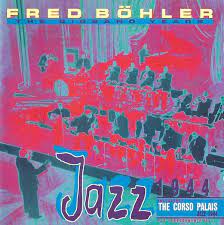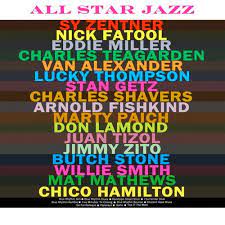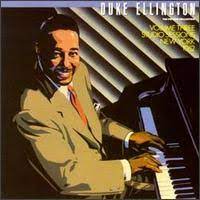
Daily Dose Of Jazz…
Alfred “Fred” Böhler was born July 26, 1912 in Zurich, Switzerland. He started on violin as a child but later switched to piano. He led his own ensemble starting in 1936, which featured Eddie Brunner and Hazy Osterwald, among others, as sidemen. This group made several tours of Switzerland during World War II and recorded copiously for Columbia Records.
In 1943, Böhler conducted an orchestral ensemble that played symphonic jazz. While he recorded most often on piano, he also used Hammond organ early in a jazz context. He would eventually play with Marcel Bianchi, Edith Piaf, Josephine Baker, and Pierre Cavall among others.
Pianist, Hammond organist and bandleader Fred Böhler transitioned on January 10, 1995 in Zumikon, Switzerland.
More Posts: bandleader,history,instrumental,jazz,music,organ,piano

Daily Dose Of Jazz…
Robert Eberly was born Robert Eberle on July 24, 1916 in Mechanicville, New York. He changed the spelling of his surname slightly to the homonymous Eberly. His father was a policeman, sign-painter, and tavern-keeper.
He was hired by the Dorsey Brothers Orchestra in 1935 shortly after winning an amateur hour contest on Fred Allen’s radio show. He stayed with Jimmy Dorsey after Tommy left to form his own band and would be a fixture with the orchestra until drafted into the service late in 1943. In the early 1940s the Jimmy Dorsey Orchestra scored a string of hits featuring Bob and Helen O’Connell, with Eberly singing a slow, romantic baritone version of songs such as Amapola and Tangerine, followed by a lighter, up-tempo reprise by O’Connell. He recorded the original version of I’m Glad There Is You in 1942 for Dorsey’s orchestra on Decca Records. The song has become a jazz and pop standard.
In 1953, Eberly and Helen O’Connell headlined a summer replacement program for Perry Como’s CBS television show. The program also featured Ray Anthony and his orchestra.
In 1980, he had one lung removed but still continued to sing. Vocalist Bob Eberly transitioned from cancer on November 17, 1981 in Glen Burnie, Maryland, at the age of 65.
More Posts: history,instrumental,jazz,music,vocal

Daily Dose Of Jazz…
Gorni Kramer was born Francesco Kramer Gorni on July 22, 1913 in Rivarolo Mantovano, Lombardy, Italy. Learning music at a very young age, thanks to his musician father. The first instrument he learned how to play was the accordion, with which he performed as a child in his father’s band.
He studied double bass at the Conservatory in Parma, Italy and obtained his diploma in 1930. He started working as a musician for dance bands and in 1933 at 20, he formed his own jazz group. This new American musical genre was forbidden by the Italian fascist regime, but Gorni got to know it thanks to some fellow musicians who worked on board the liners connecting Europe and North America.
In the middle of the Thirties he became a successful songwriter, composing hit songs through the Thirties. In spite of his songs’ popularity, Gorni and his orchestra were still ignored by the Italian state radio EIAR, who boycotted them because they played jazz.
During World War II he worked with Natalino Otto, a singer also banned by EIAR because of swing and wrote one of her greatest hits. In 1949 he started working for Garinei and Giovannini, a very famous duo of impresarios who authored and produced musical comedies, an association that lasted ten years.
Kramer debuted on television in 1957 with Il Musichiere music show, composing the show’s theme song with other shows ensued. In the mid-1960s he gradually reduced his public performances, but he continued to work as a music publisher and a TV author.
Songwriter, bassist and bandleader Gorni Kramer transitioned from a heart attack on October 26, 1995 in Milan, Italy.
More Posts: bass,history,instrumental,jazz,music

Daily Dose Of Jazz…
Arnold Fishkind was born July 20, 1919 in Bayonne, New Jersey, and grew up in Freeport, Long Island, New York where he met and began a lifelong friendship with Chubby Jackson. At age 7 Fishkind began learning violin, and played in The Musical Aces, a local band of budding musicians. By age 14 he was playing bass.
Fishkind had his first professional gig with Bunny Berigan in 1937. Following this he played with Jack Teagarden, Van Alexander, and Les Brown in the early Forties. After serving three years in the armed forces during World War II he met and played with pianist Lennie Tristano in New York, but by the fall he left to go to Hollywood to play with Charlie Barnet. During this experience he played alongside Stan Getz.
Returning to New York City from 1947 to 1949 he played with Tristano, then at the end of the decade recorded with Lee Konitz and on Johnny Smith’s Moonlight in Vermont. He also continued to play with Barnet, and played with Benny Goodman.
By the 1950s he found much work as a session musician, for radio, television and pop musicians including Frankie Laine. His career at ABC lasted fifteen years and included appearances in the Andy Williams Show in 1961. Fishkind became well known enough during this time to be mentioned by Jack Kerouac in his novel Visions of Cody.
Rock and Roll having decimated the market for jazz musicians in New York City, Fishkind moved from New York City back to California. In California he found work with the Dean Martin and Bob Hope television shows and some substitution engagements on the Tonight and Merv Griffin television shows, as well as some recording and film work.
He toured with Les Brown and Lena Horne, while continuing to record into the 1980s, playing with Frank Scott. Ultimately he moved to Palm Desert, California, where he was able to join the celebration of his friend Chubby Jackson’s 80th birthday. In his latter years, Fishkind became an ordained minister at Family Life Church in Palm Desert.
During his career he performed swing and bebop jazz, television, jingles, and even western themed music. He worked with Ella Fitzgerald, Stan Hasselgard, Peanuts Hucko, Charlie Parker, Shorty Rogers, Butch Stone and Jerry Wald. Bassist Arnold Fishkind, sometimes credited as Arnold Fishkin and who appeared on over 100 albums, transitioned on September 6, 1999 in Palm Desert, California.
More Posts: bass,history,instrumental,jazz,music

Daily Dose Of jazz…
Ernest Shepard, Jr. on July 19, 1916 in Beaumont, Texas and played in territory bands in Texas in the 1930s and soon after worked in California in the bands of Phil Moore and Gerald Wilson.
For a short time he played in a quintet with Charlie Parker and Dizzy Gillespie in 1945. Later that year he recorded as a vocalist with Lem Davis and worked with Eddie Heywood in 1945-1946.
In the Fifties he worked with Slim Gaillard, Gene Ammons, Sonny Stitt, and Johnny Hodges, but played little in the latter half of the decade. In 1962 he became a member of Duke Ellington’s band and accompanied him on tours of Europe through 1964.
He worked with Paul Gonsalves in 1963 and Johnny Hodges in 1964 then moved to Germany in 1964. He took up work as a session musician for studio recordings, radio, and television.
Double-bassist and vocalist Ernest Shepard transitioned on November 23, 1965 in Hamburg, West Germany.
More Posts: bass,history,instrumental,jazz,music


